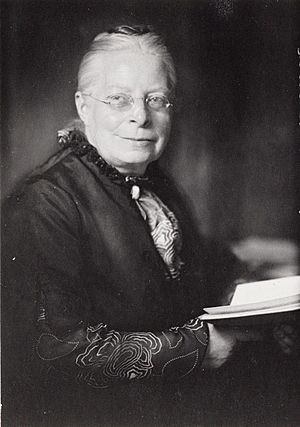Catharine van Tussenbroek facts for kids
Quick facts for kids
Catharine van Tussenbroek
|
|
|---|---|

Van Tussenbroek c. 1890
|
|
| Born |
Albertina Philippina Catharina van Tussenbroek
4 August 1852 |
| Died | 5 May 1925 (aged 72) Amsterdam, Netherlands
|
| Nationality | Dutch |
| Occupation | physician, feminist |
| Known for | first physician to confirm ovarian pregnancy clinically |
Catharine van Tussenbroek (born August 4, 1852 – died May 5, 1925) was a Dutch doctor and a supporter of women's rights. She was the second woman in the Netherlands to become a doctor. She was also the first doctor to prove that a rare medical condition called ovarian pregnancy could happen. This is when a baby starts to grow in the wrong place, on the ovary. A special fund was later created in her name. It helps women researchers today, continuing her work to support women.
Biography
Catharine van Tussenbroek was born in Utrecht on August 4, 1852. Her parents were Cornelia van der Voort and Gerardus van Tussenbroek, who was a carpenter.
She first trained to be a teacher. She earned her assistant teacher certificate in 1870. Then, in 1875, she became a head teacher.
In 1880, she made history by becoming the first woman to be accepted into Utrecht University. There, she studied medicine. She earned her Ph.D. in Medicine in 1887.
After finishing her studies, she moved to Amsterdam. She started working as a general doctor. She focused on treating women and children.
In 1898, she joined the Dutch Medical Examination Board. Soon after, she became a professor of women's health (gynecology) at Utrecht University. In 1890, she also became an assistant doctor specializing in women's health at the Boerhaave Kliniek in Amsterdam. At that time, very few women doctors became specialists.
She worked and studied with Dr. Mendes de Leon for eight years. She became very well-known and was often asked to give advice outside of Amsterdam. By 1891, she was the secretary of the Dutch Society of Gynecology.
Catharine van Tussenbroek cared a lot about women's health. She spoke out against tight corsets. She told women to wear loose clothing instead.
In 1898, she gave a speech called "The Lack of Life Spirit in Our Young Women and Girls." This was at the start of the Exhibition of Women's Work in The Hague. In her speech, she argued that women should be able to earn their own money. She believed that if women only aimed for marriage, it was bad for their health. She encouraged physical activity and job training for women.
"First and foremost, I believe we women need to have trust and respect in ourselves. I believe that through diligent labour we will achieve economic independence. The conventional image of the woman will then evolve into a new concept. How it will look, I dare not predict. But of one thing I am certain: we women embody the ideal whether we bear the broom, wield the scalpel or stand at the helm of the state."
Van Tussenbroek loved doing research. She would have preferred to study tiny cells under a microscope. But the health needs of women were very urgent.
In 1899, she made an important medical discovery. She clearly showed the first accurate description of a rare condition called ovarian pregnancy. This is when a fertilized egg starts to grow on the ovary instead of in the uterus. Other doctors had set rules for what counted as a true ovarian pregnancy. Van Tussenbroek's report met all these rules. She found that the ovary and tube were normal. The sac on the ovary held a tiny embryo. This sac was connected by a cord. The sac also had special folds of tissue.
At first, many doctors were doubtful. But three years later, her findings were proven correct. Still, some doctors remained unsure even into the 1920s.
In 1902, she helped write a study about cervical cancer in the Netherlands. She also worked as an editor for important medical journals. These included the Netherlands Journal of Medicine. She also edited the Netherlands Journal of Obstetrics and Gynecology.
Van Tussenbroek was on the board of the Dutch Society for the Advancement of Medicine. She also wrote many articles for medical journals. In 1898, she published a book called "Introduction to the Study of School Hygiene." In 1911, she published "The Development of Aseptic Obstetrics in the Netherlands." She wrote these books with Dr. J. Blok and C. H. de Jong.
She was also active in politics. She was a member of the Society for Women's Suffrage. This group worked to give women the right to vote. She even wore a special pin with the picture of an American suffragette, Carrie Chapman Catt.
From 1910 to 1916, she was a leader in the National Association for Female Labor. She was first vice-president, then president. In 1919, Dutch women finally got the right to vote. That year, she ran for parliament with the General Netherlands Women's Organization. However, she did not win the election.
Catharine van Tussenbroek passed away in Amsterdam on May 5, 1925.
Legacy
After Catharine van Tussenbroek died, a special fund was created in her name. Dr. Marianne Herwerden started this fund in 1926. She was part of the Dutch Association of Women in Academic Education.
This fund helps Dutch women scholars. It gives them money to study in the Netherlands or in other countries. It also helps them finish their research for graduate degrees. This way, Catharine van Tussenbroek's work to empower women continues.
See also
 In Spanish: Catharine van Tussenbroek para niños
In Spanish: Catharine van Tussenbroek para niños


